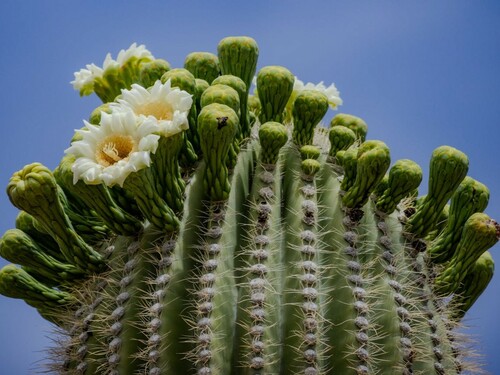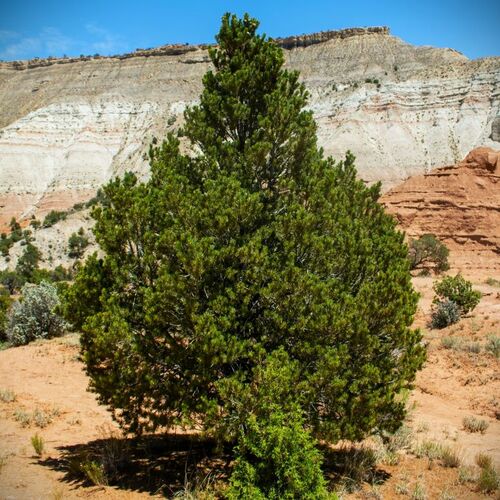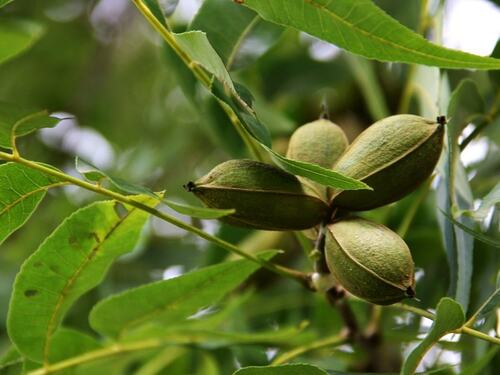Discover the Unique Stories Behind America’s State Trees and Flowers Part 4: The Southwest
Introduction
The American Southwest is a land of contrasts and beauty and is home to some of the most unique plants in the country. Each state in this region has chosen trees and flowers that represent their culture and identity. These plants, from the Saguaro Cactus to the Bluebonnet, tell stories of survival and the deep connection between people and nature around them. Join us as we discover the fascinating stories behind these plants and uncover just how they show off the spirit of the southwest.
ARIZONA

A Flowering Saguaro Cactus – Photo by TAG
Arizona’s state tree is the Palo Verde , which translates to “Green Stick” in Spanish. This tree is perfectly suited to growing in Arizona’s dry deserts and rocky hills. One of the Palo Verde’s most striking traits is its bright green bark. This green bark isn’t just for looks– it’s a clever adaptation that lets the tree absorb most of its energy from the sun through its bark instead of just its leaves. This strategy helps the Palo Verde save water in the dry desert by reducing the leaf surface area. Despite usually not having very many leaves, in the spring this tree bursts into bloom. During this time, the tree becomes covered in small, bright yellow flowers. This creates the illusion of the tree being wrapped in gold. This Dazzling display not only brings beauty to the landscape but is also important for desert pollinators. This is because it brings forth supplies crucial for their survival. The Palo Verde’s ability to live in tough conditions and still look pretty makes it a good symbol for Arizona’s tough spirit.
From the “green stick” that paints the desert gold to a giant that wears a crown of fleeting white, Arizona’s state symbols capture the essence of desert life. The Saguaro Cactus is Arizona’s state flower. This cactus is the biggest kind of cactus in the United States. It can grow over 40 feet tall! These cacti grow slowly and can live up to 200 years old. Despite how big they are, the Saguaro Cactus has very delicate, beautiful flowers that bloom between May and June. These large, white flowers open at night, and close by the following day, and are the state flower of Arizona. An interesting fact about these flowers is that they have a strong scent that often smells like overripe melons. This scent, along with blooming at night, is used to attract bats and moths. These creatures are the main pollinators of the cactus. People celebrate the short lives of this flower every year. Not only does it mark the change from spring to summer, but it is also important to the desert’s ecosystem. The Saguaro Blossom shows the beauty of Arizona and the strength of life in the desert. This makes it a good choice as the state flower of Arizona.
NEW MEXICO

A Lone Piñon Pine in the Desert – Photo by Zoshua Colah on Unsplash
New Mexico’s state tree, the Piñon Pine, was designated as New Mexico’s state tree in 1949. It’s a common sight in New Mexico’s landscapes, particularly at elevations between 5,000 and 7,000 feet. This tree is not very tall, usually growing around 20-30 feet tall– about the height of a two-story house. The Piñon Pine is best known for its pine nuts, which have been an important food source for thousands of years. These nuts are still popular in New Mexican cooking today! This Pine also plays an important role in nature, providing good and shelter for many kinds of animals. The tree’s sweet-smelling wood has also been used in fires and woodcraft. While these trees are good at surviving in tough conditions, they can have problems with certain insects and long droughts . The Piñon Pine shows us how one tree can be important in so many ways – for food, for nature, and for a state’s culture and history.
While the Piñon Pine offers its nuts from above, New Mexico’s ground-level survivor packs a different kind of punch. New Mexico’s state flower, the Yucca , is a tough plant that thrives in the state’s dry climate. It has long, sword-like leaves and a tall talk with clusters of creamy-white, bell shaped flowers that bloom in late spring or early summer. The Yucca has deep cultural importance to the Native American tribes. These people have used this plant for centuries, making sandals, baskets, and rope out of its tough leaves. Its roots were also used as a soap, earning the nickname “soapweed.” The flowers and fruit can also be eaten both raw and cooked. The Yucca is also important to nature– it has a special symbiotic relationship with the Yucca moth as a pollinator. While Yuccas are good at surviving harsh conditions, they can sometimes spread too much in certain areas. This flower reminds us of New Mexico’s unique landscape and the clever ways people have learned to live in dry places. It shows how a plant can be both beautiful and useful, as well as why it’s important to protect native species.
OKLAHOMA

A Bright-Red Oklahoma Rose
Oklahoma’s state tree, the Redbud, is a small but mighty presence in the landscape. This small tree is native to eastern North America and thrives in Oklahoma’s climate. These trees burst into life with pink to purple flowers in the early spring, a welcome sight after winter. While their beauty is undeniable, Redbuds play a bigger role than just looking pretty. They’re a good source of early-season food for pollinators, which is essential for the habitat. Redbuds grow to about 20-30 feet tall, often with multiple trunks. They are popular in yards , but also grow wild across eastern North America. Native American tribes have long valued the tree for food and medicine. This adds cultural significance to the tree’s natural importance. As Oklahoma’s state tree, the Redbud represents both the natural state beauty and the ongoing need to balance human activity with environmental preservation. It’s a reminder that even small trees can have a big impact on their surroundings.
If the Redbud tree is Oklahoma’s springtime fireworks show, then the state flower is its perfume. The Oklahoma rose is the official state flower of Oklahoma. It was adopted in 2004 to replace the mistletoe. This wild rose species is native to the state and is well-known for its fragrance. In fact, it’s one of the most aromatic tea roses. The Oklahoma rose usually produces pink, five-petaled flowers with yellow centers and bloom from late spring through early summer. It’s celebrated for its strength, thriving in both droughts and the cold. But the Oklahoma Rose also faces challenges common to many native species, like loss of habitat and climate change. The plant is small, usually about 3 feet tall and wide. This makes it a good choice for gardens and landscapes across the state. By choosing this beautifully scented native species as its state flower, Oklahoma shows its commitment to protecting its natural history and celebrates a unique and aromatic representation of the state’s plants.
TEXAS

Nuts & Leaves on a Pecan Branch – Image by Gretta Blankenship from Pixabay
The Pecan Tree, Texas’s state tree, is a true Lone Star native with deep roots in the region’s history. Fossil evidence shows that Pecan trees lived in Texas long before humans did! These long-lived trees can survive for thousands of years, standing as living monuments to the state’s history. Despite their incredible lifespan, Pecan trees are known for their relatively soft wood. This makes its wood less suitable for heavy construction. However, it is prized for making high-quality flooring and furniture, where its color and grain can be shown. The Pecan isn’t just important for its timber; it’s also Texas’s official health nut! Its nutrient-rich nuts have been a staple food source for native peoples and settlers alike; so much so that it is integral to Texas food and culture. Today, Texas is a global leader in pecan production! The Pecan tree’s history, long-life, usefulness, and value make it a good symbol for the enduring spirit of Texas.
While the Pecan tree stands tall as a testament to Texas’s enduring history, another state symbol carpets the ground with a fleeting but unforgettable beauty. The bluebonnet became Texas’ official flower in 1901 and is an iconic symbol of the Lone Star State. These bright blue flowers pop up all over Texas, usually blooming in March and reaching their peak in April. This widespread presence is because of the state’s efforts to plant flowers along its roads, the first state to do so. This created stunning blue sights for travelers. Bluebonnets thrive in the full sun, making them perfectly adapted to Texas’ warm, sunny weather. Now, this beloved flower draws visitors from all over to see the breathtaking fields of blue flowers in the spring. They’ve become a special part of Texas culture, mixing natural beauty with the state’s history of caring for its landscapes.
In Conclusion
As we finish our journey through the state trees and flowers of the Southwest, we’re reminded of the wonderful variety and strength of nature. Each plant reflects something important about its state, and are windows into their unique landscapes, habitats, and histories. By understanding and appreciating these natural symbols, we get a deeper connection to the land and the people who have called it home for generations. It also shows us the importance of preserving these natural treasures for the future.
Check out the other blogs in this series:


